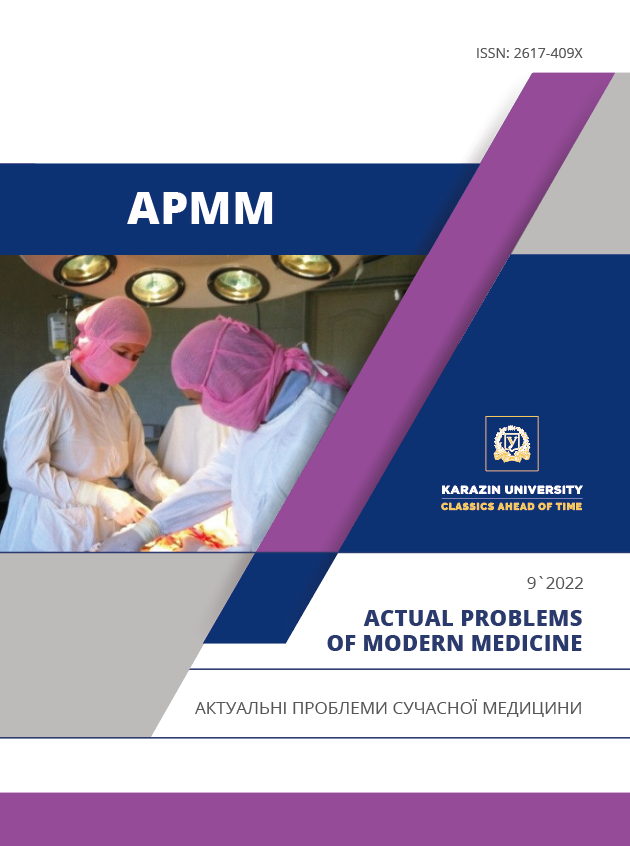Clinical and neurophysiologival efficacy of transcranial magnetic stimulation treatment in patients with stage II Parkinson's disease
Abstract
Summary. The aim of our study was to determine the clinical and neurophisiological effectiveness of transcranial magnetic stimulation treatment in patients with stage II Parkinson's disease (PD). Materials and methods. The prospective randomised placebo-controlled study included 90 patients aged 49 to 75 years with stage II PD according to Hoehn-Yahr. All patients were randomized to two groups of 45 in each for a TMS course: group 1 included patients assigned to a real TMS course, while group 2 included placebo TMS sessions. All patients on the background of basic PD therapy were additionally prescribed a course of therapeutic TMS sessions according to the protocol in zones C3, C4 and Cz of the brain (projection of the premotor cortex according to the international system 10-20%) with a pulse frequency in the series of 5 Hz and a total number of pulses of 2000 per session. During the study, patients were examined twice: at the beginning and at the end of TMS sessions. Examination of patients was performed according to the following scheme: clinical and neurological examination using SPES SCOPA Motor scale and neurophysiological examination to determine the latency, amplitude, area and duration of motor evoked potential (MEP) after 2 tests with a gradual increase of magnetic field induction. Results. TMS treatment resulted in a significant reduction in MEP latency (p<0,001) in patients from with real TMS group, while it was found no reduction in MEP latency (p> 0,05) in placebo-TMS patients. The amplitude of the MEP of the left and right premotor cortex did not change significantly either in the group with real TMS (p>0,05) or in the group of placebo-TMS (p>0,05). The duration of MEP increased significantly (p <0,001) after the course of TMS, and in the placebo-TMS group no significant changes were found (p> 0,05). Conclusions. Treatment with TMS leads to a clinical reduction in the manifestations of motor symptoms of PD using the SPES SCOPA Motor scale score, namely to a decrease in the amplitude of rest and postural tremor, bradykinesia, rigidity and gait disorders. Also TMS leads to a significant decrease in the latent period of MEP and increase the duration of MEP.
Downloads
References
Bologna M, Guerra A, Paparella G. Neurophysiological correlates of bradykinesia in Parkinson’s disease. Brain. 2018;141(8):2432—2444. DOI: 10.1093/brain/awy155.
Chung CL, Mak MK. Effect of repetitive transcranial magnetic stimulation on physical function and motor signs in Parkinson’s disease: a systematic review and
meta-analysis. Brain Stimul. 2016;9(4):475—487. DOI: 10.1016/j. brs.2016.03.017.
Dagan M, Herman T, Mirelman A, Giladi N, Hausdorff JM. The role of the prefrontal cortex in freezing of gait in Parkinson’s disease: insights from a deep repetitive transcranial magnetic stimulation exploratory study. Exp. Brain Res. 2017;235(8):2463—2472. DOI 10.1007/s00221-017-4981-9.
Dileone M, Carrasco-López MC. et al. Dopamine-dependent changes of cortical excitability induced by transcranial static magnetic field stimulation in Parkinson’s disease. Scientific Reports. 2017;7:4329.
Kojovic M, Kassavetis P, Bologna M. et al. Transcranial magnetic stimulation follow-up study in early Parkinson’s disease: A decline in compensation with disease progression? Mov Disord. 2015;30(8):1098—1106. DOI: 10.1002/mds.26167.
Kolmancic K, Perellón-Alfonso R, Pirtosek Z. et al. Sex difference s in Parkinson’s disease: A transcranial magnetic stimulation study. Mov Disord. 2019;34(12):1873 — 1881. DOI: 10.1002/mds.27870.
Latorre A, Rocchi L, Berardelli A, Bhatia KP, Rothwell JC. The use of transcranial magnetic stimulation as a treatment for movement disorders: A critical review. Mov. Disord. 2019;34(6):769—782. DOI: 10.1002/mds.27705.
Lefaucheur JP, Aleman A, Baeken C, Benninger DH, Brunelin J, Di Lazzaro V, et al. Evidence-based guidelines on the therapeutic use of repetitive transcranial magnetic stimulation (rTMS): An update (2014 — 2018). Clin. Neurophysiol. 2020;131(2):474—528. DOI: 10.1016/j.clinph.2019.11.002.
Lefaucheur J, Andre-Obadia N, Antal A. et al. Evidencebased guidelines on the therapeutic use of repetitive transcranial magnetic stimulation (rTMS). Clin. Neurophysiol. 2014;125(11):2150—2206. DOI: 10.1016/j. clinph.2014.05.02127.
Matsumoto H, Ugawa Y. Repetitive transcranial magnetic stimula- tion for Parkinson’s disease: a review. Brain Nerve. 2017;69(3):219—225. DOI: 10.11477/mf.1416200730.
Van den Noort M, Bosch P, Yeo S, Lim S. Transcranial magnetic stimulation for Parkinson’s disease. Mov Disord. 2015;30(14):1973. DOI: 10.1002/mds.26439.
Wagle Shukla A, Shuster JJ, Chung JW. et al. Repetitive transcranial magnetic stimulation (rTMS) therapy in Parkinson disease: a meta-analysis. PMR. 2016;8(4):356—366. DOI: 10.1016/j.pmrj.2015.08.009.
Yang C, Guo Z, Peng H. et al. Repetitive transcranial magnetic stimulation therapy for motor recovery in Parkinson’s disease: a meta-analysis. Brain Behav. 2018;8(11). DOI: 10.1002/brb3.1132.
Zafar S, Yaddanapudi SS. Parkinson Disease. 2021 Aug 11. In: StatPearls [Internet]. Treasure Island (FL): StatPearls Publishing; 2022 Jan–.
Zanjani A, Zakzanis KK, Daskalakis ZJ, Chen R. Repetitive tran- scranial magnetic stimulation of the primary motor cortex in the treatment of motor signs in Parkinson’s disease: A quantitative review of the literature. Mov. Disord. 2015;30(6):750—758. DOI: 10.1002/mds.26206




